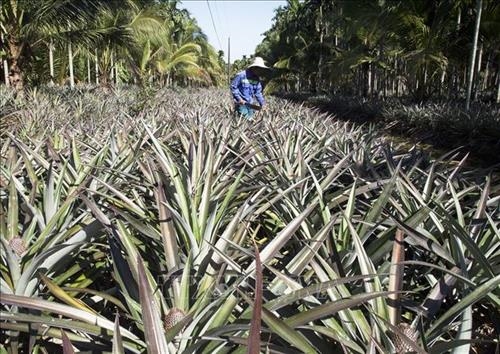Ho Van Dao, who has grown the fruit under the VietGAP standards for one year, said he had harvested 6,000 pineapples per hectare per year compared to 4,500 pineapples per hectare a year in the previous years.
VietGAP pineapples are bought at a higher price because they look better, he said.
    |
 |
|
Growing pineapples in Binh An commune (Photo: dantocmiennui.vn) |
They sell for 7,000 -12,000 VND (0.3-0.52 USD) a fruit, which is 1,000-2,000 VND higher than pineapples planted under traditional farming methods.
Farmers growing pineapples under the VietGAP standards earn a profit of nearly 50 million VND (2,160 USD) per hectare a year.
Organic fertilizer, which improves soil fertility, helps to reduce labor costs spent for tending the fruit.
Tac Cau pineapples have been planted in the Mekong Delta province for more than 70 years, mostly in Chau Thanh and Go Quao districts.
Tac Cau pineapples are planted in fields or intercropped in coconut and areca orchards. The pineapple is resistant to disease and is well known for its deliciousness and sweetness compared to other pineapple varieties.
Chau Thanh district has about 1,700ha of Tac Cau pineapple with a yield of 10-12 tons a year, including 1,260ha in Binh An commune.
Binh An has chosen the pineapple as a key agricultural produce since its soil is affected by alum and saltwater intrusion, which is suitable for growing pineapple.
In Binh An, 49 households have been granted VietGAP certificates to grow Tac Cau pineapples on a total area of 70ha.
The commune’s authorities provided farmers with techniques to cultivate fruit under VietGAP standards as well as 200 kilograms of organic fertilizer per hectare a year.
Luc Duc Long, an official in the Binh An Engineering Economy Division, said the households previously had problems growing the fruit but then agreed to implement the standards if they received training.
The cultivation of VietGAP pineapples has enhanced farmer awareness about VietGAP standards and improved the quality of pineapples, he said.
Under VietGAP standards, farmers have to strictly follow the processes of choosing seedlings, tending and harvesting under the standards.
The output of pineapples under VietGAP standards is 15-25 percent higher than pineapples planted under traditional farming methods.
The weight of VietGAP pineapples is 1.6 -1.7 kilogram a fruit compared to 1.2 kilogram a fruit from traditional farming methods.
Farmers in the commune are harvesting pineapples for the coming Tet (Lunar New Year) Festival, which falls on January 25.
Pineapple is one of fruits which are in high demand for the festival as it is used on most family altars.
Nguyen Quoc Linh, chairman of the Binh An Farmers Association, said the cultivation of VietGAP pineapples produced good-looking pineapples with even quality.
It has also offered higher profits, and protected the environment and health of farmers, he said.
The commune plans to expand Tac Cau pineapple area under VietGAP standards to improve income for farmers and create sustainable production.
Tac Cau pineapple are eaten fresh and used to make other products like pineapple cakes, dried pineapples, juice and jams. The province’s processed pineapples are sold domestically and exported.
Source: VNA